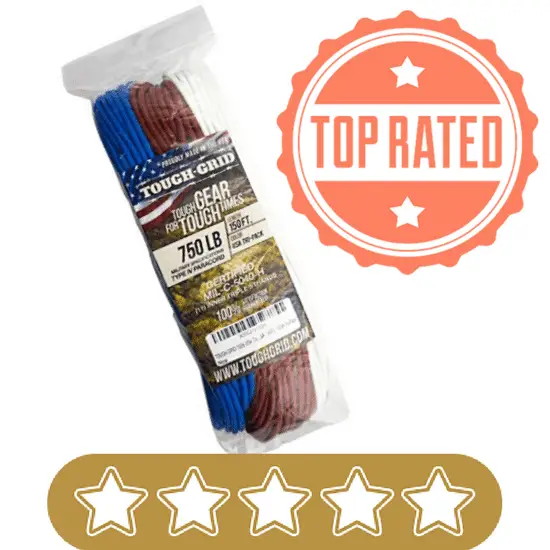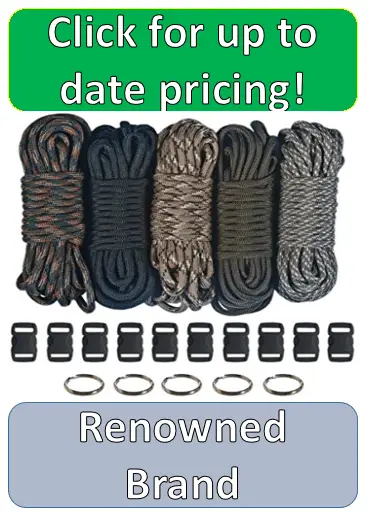Paracord has really become a popular item in the world of outdoor enthusiasts and survivalists alike in recent years, and it’s not hard to see why. Reliable, extremely versatile, and able to offer tons of uses in a very small lightweight package, there’s a lot to love about paracord.
Not a lot to criticize. However, many people are surprised to find out just how many different sizes of paracord are actually available out there!
While 550 paracord is by far and away the post popular, and common, there are six official military grades of parachute cord with 550 and 750 being the two most popular. Outside of military grade there are commonly around 12-15 “new” sizes of paracord on the civilian market.
However, in the civilian survival market that are many more with 15 different common sizes of paracord available from many places. Paracord starts from 0.75mm Nano Cord at the smallest and goes all the way up to 1/4 shock cord.
In other words, there’s a lot happening in the world of paracord. Thankfully, we have information on all your questions below. By the end of the article you will be a paracord expert!

Table of Contents
Military Grade Paracord
There are six types of paracord that are considered military grade. While the other 9 that are commonly sold can definitely be useful and are easy to find, they are not going to be technically military grade. This isn’t a big deal for most buyers but in some cases that might be a buying consideration.
You can tell when a paracord is military grade based on how it is listed. These are the cords with a 3-digit number in the beginning. So 95 cord, 275 cord, 325 cord, 425 cord, 550 cord, and 750 cord. There are companies that make cord that is stronger, weaker, and in many different areas in between, as well.
However, now you know how to tell if parachute cord is military grade or not!
The following list is from smallest or “weakest” to the largest and strongest. That being said, even the smallest options tend to be strong and well made. This was designed for use with parachutes, after all.
So to summarize, the six types of “official” military grade paracord are:
- 95 cord
- 275 cord
- 325 cord
- 425 cord
- 550 cord
- 750 cord
Non-Military Grade Paracord
When looking at pure parachute cord you will want to stay with the military grade options. That being said, this is a popular and useful enough item that there are many more varieties made and available in the consumer market.
These can be extremely useful and some might be a better fit for your custom project than conventional military grade parachute cord so
The Smallest: Nano Cord
This is the thinnest cord you’ll find around. This type of paracord is great for crafting, as well as creating survival bracelets or pieces where you want a LOT of cord once it is all unwound. This comes at 36 lb. tensile strength at only .75 mm in overall diameter. While this isn’t earth-shattering it is an outstanding option when space is at an absolute premium.
Micro Cord
At a mere 1.18mm micro cord is a form of paracord that is small but fierce. This is also the smallest option available before you hit the smallest military grade paracord (95). This can work on its own but it is often used in conjunction with 550 paracord for crafting, survival, or basic backwoods camp uses. Rated for up to 100 lbs of tensile strength.
95 Cord
The smallest of the military grade paracord, this is slightly thicker than micro cord while providing the same exact level of tensile strength. Tested and approved from 90-100 lbs, 95 has one inner strand and used for a wide variety of needs. These are often used with 3/8, 1/2, and 5/8 inch buckles. Not as common as 550 paracord survival bracelets but they are out there.
275 Cord
This is one of the stiffest paracords out there. 275 cord is made by packing 5 strong strands into a small 2mm sheath. These are good for smaller projects and hits that middle ground where it gives plenty of strength but doesn’t quite have the flexibility of some of the slightly larger types of parachute cord where the different design allows a little bit more folding.
That said, sometimes a project calls for a bit more stiffness and support – and the 275 can offer that.
325 Cord
This is the cord that most crafters or bushwork fans find as the happy medium between the tiny micro cord or the more traditional 550 that everybody and their cousin seems to be using. This is the type of cord for when you need some serious strength and durability but you also want something that is smaller than the traditional 550.
425 Cord
425 is a heavy duty cord that is only slightly smaller than the 550 but it is noticeable. Offering 425 lbs of tensile strength, the three inner strands come together to create that solid and strong connection that makes for a reliable yet flexible cord. If the 550 is just barely too big for your needs the 425 is the way you should go.
1/8 Shock Cord
Designed to be extremely elastic, while also extremely resistant to snapping, this is the type of cord that is often used with others for creating hammocks, interior tent pole cord, or even bungee straps.
This is often used for cargo nets, as well. In other words, it’s a very different type of cord from your traditional parachute cord options, but it gets the job done for those specialty projects where strength while stretching in an elastic way is crucial.
Survival/Mono Cord
Measuring at 5/32 of an inch and with 7 cords these have over double the cords of the 325 and 425 to do some serious lifting, similar to what the tinder cord has to offer.
This can go by different names from provider to provider as they tend to hit that space that goes between the smaller ones and before you hit the heavy duty military cord like the 550 and 750.
550 Cord
This is the most popular paracord and is seen by many as the “default.” Featuring a 4mm diameter with 7 inner strands this U.S. military approved paracord is flexible, strong, and gets the job done. Survival bracelets made from these offer plenty of strong cord for knots, lashing, creating shelter, tools, or a variety of other uses.
Some cord can even be shredded with a knife for fire-starting purposes while still leaving plenty behind. If you’re looking at buying paracord from a survival or prepper store chances are you’re looking at 550.
750 Cord
This is the heavy duty stuff. The largest the military makes, it is larger than the 550 at a 5mm diameter with 11 strands inside. “Heavy duty” doesn’t even begin to cover this cord. Used for things like belts, leashes, or emergency products, the 750 cord is a strong nylon paracord that is rated as a full 26% stronger than the traditional popular 550 cord.
Para-Max Cord
This cord is a full 1/4 of an inch in diameter making it a larger more rope-like cord. These tend to only have three inner strands which come together for a thick and firm setup that can go through truly heavy duty work even above and beyond the 750 cord.
1/4 Shock Cord
These are more bungee-type cords that bring the resistance and strength from traditional paracord while using modern materials to give more elastic give without sacrificing any of the strength you expect from paracord or paracord alternatives.
Why Is 550 the Most Popular?
There are many reasons for these. For many people 550 cord is the perfect combination of being small (only 4mm in diameter) while being more than strong enough for most projects.
There is an abundance of this material, it’s versatile, and it’s likely to last even when used in rough conditions. Those are winning combinations for sure!
So What’s This Mean?
Unless you have some extraordinary circumstances chances are that the popular 550 will be more than enough for whatever you need. However, there are many options when it comes to a quality paracord.
Whatever your project, whatever your needs, one of these is sure to offer everything you need and then some!

